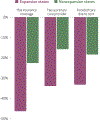The Affordable Care Act Reduced Socioeconomic Disparities In Health Care Access
- PMID: 28747321
- PMCID: PMC8087201
- DOI: 10.1377/hlthaff.2017.0083
The Affordable Care Act Reduced Socioeconomic Disparities In Health Care Access
Abstract
The United States has the largest socioeconomic disparities in health care access of any wealthy country. We assessed changes in these disparities in the United States under the Affordable Care Act (ACA). We used survey data for the period 2011-15 from the Behavioral Risk Factor Surveillance System to assess trends in insurance coverage, having a personal doctor, and avoiding medical care due to cost. All analyses were stratified by household income, education level, employment status, and home ownership status. Health care access for people in lower socioeconomic strata improved in both states that did expand eligibility for Medicaid under the ACA and states that did not. However, gains were larger in expansion states. The absolute gap in insurance coverage between people in households with annual incomes below $25,000 and those in households with incomes above $75,000 fell from 31 percent to 17 percent (a relative reduction of 46 percent) in expansion states and from 36 percent to 28 percent in nonexpansion states (a 23 percent reduction). This serves as evidence that socioeconomic disparities in health care access narrowed significantly under the ACA.
Keywords: Access To Care; Affordable Care Act; Insurance Coverage < Insurance; Medicaid; Socioeconomic Disparities.
Project HOPE—The People-to-People Health Foundation, Inc.
Figures



Comment in
-
Disparities In Access: The Authors Reply.Health Aff (Millwood). 2017 Dec;36(12):2211. doi: 10.1377/hlthaff.2017.1242. Health Aff (Millwood). 2017. PMID: 29200342 No abstract available.
-
Reducing Disparities In Access To Health Care.Health Aff (Millwood). 2017 Dec;36(12):2211. doi: 10.1377/hlthaff.2017.1241. Health Aff (Millwood). 2017. PMID: 29200344 Free PMC article. No abstract available.
References
-
- Henry J Kaiser Family Foundation. Status of state action on the Medicaid expansion decision [Internet]. Menlo Park (CA): KFF; 2017. [cited 2017 Jun 19]. Available for download from: http://www.kff.org/health-reform/state-indicator/state-activity-around-e...
-
- Mensah GA, Mokdad AH, Ford ES, Greenlund KJ, Croft JB. State of disparities in cardiovascular health in the United States. Circulation. 2005;111(10):1233–41. - PubMed
-
- Pappas G, Queen S, Hadden W, Fisher G. The increasing disparity in mortality between socioeconomic groups in the United States, 1960 and 1986. N Engl J Med. 1993; 329(2):103–9. - PubMed
-
- Ward E, Jemal A, Cokkinides V, Singh GK, Cardinez C, Ghafoor A, et al. Cancer disparities by race/ethnicity and socioeconomic status. CA Cancer J Clin. 2004;54(2):78–93. - PubMed
Grants and funding
LinkOut - more resources
Full Text Sources
Other Literature Sources
Miscellaneous

